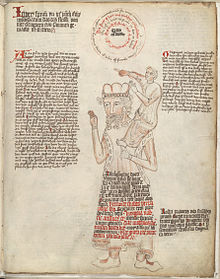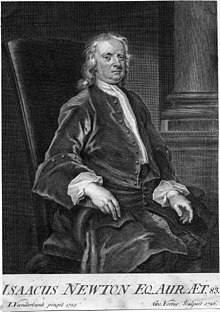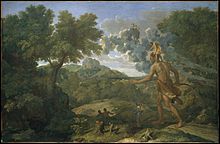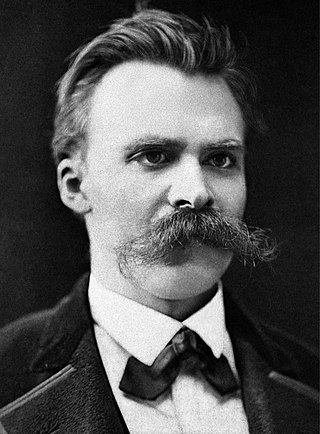
Friedrich Wilhelm Nietzsche was a German philosopher. He began his career as a classical philologist before turning to philosophy. He became the youngest person to hold the Chair of Classical Philology at the University of Basel in 1869 at the age of 24, but resigned in 1879 due to health problems that plagued him most of his life; he completed much of his core writing in the following decade. In 1889, at age 44, he suffered a collapse and afterward a complete loss of his mental faculties, with paralysis and probably vascular dementia. He lived his remaining years in the care of his mother until her death in 1897 and then with his sister Elisabeth Förster-Nietzsche. Nietzsche died in 1900, after experiencing pneumonia and multiple strokes.

Sir Isaac Newton was an English polymath active as a mathematician, physicist, astronomer, alchemist, theologian, and author who was described in his time as a natural philosopher. He was a key figure in the Scientific Revolution and the Enlightenment that followed. His pioneering book Philosophiæ Naturalis Principia Mathematica, first published in 1687, consolidated many previous results and established classical mechanics. Newton also made seminal contributions to optics, and shares credit with German mathematician Gottfried Wilhelm Leibniz for developing infinitesimal calculus, though he developed calculus years before Leibniz.
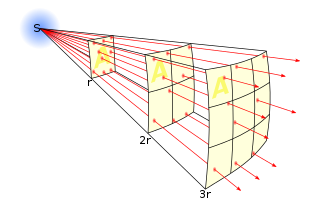
In science, an inverse-square law is any scientific law stating that the observed "intensity" of a specified physical quantity is inversely proportional to the square of the distance from the source of that physical quantity. The fundamental cause for this can be understood as geometric dilution corresponding to point-source radiation into three-dimensional space.
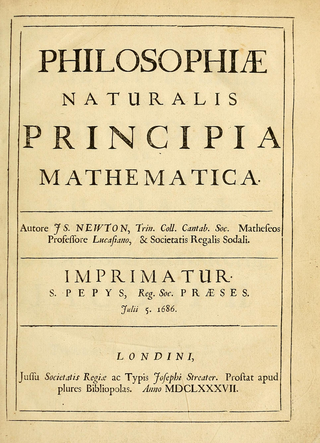
Philosophiæ Naturalis Principia Mathematica often referred to as simply the Principia, is a book by Isaac Newton that expounds Newton's laws of motion and his law of universal gravitation. The Principia is written in Latin and comprises three volumes, and was first published on 5 July 1687.

Robert Hooke was an English polymath who was active as a physicist, astronomer, geologist, meteorologist and architect. He is credited as one of the first scientists to investigate living things at microscopic scale in 1665, using a compound microscope that he designed. Hooke was an impoverished scientific inquirer in young adulthood who went on to became one of the most important scientists of his time. After the Great Fire of London in 1666, Hooke attained wealth and esteem by performing more than half of the property line surveys and assisting with the city's rapid reconstruction. Often vilified by writers in the centuries after his death, his reputation was restored at the end of the twentieth century and he has been called "England's Leonardo [da Vinci]".
The Übermensch is a concept in the philosophy of Friedrich Nietzsche. In his 1883 book, Thus Spoke Zarathustra, Nietzsche has his character Zarathustra posit the Übermensch as a goal for humanity to set for itself. The Übermensch represents a shift from otherworldly Christian values and manifests the grounded human ideal. The Übermensch is someone who has "crossed over" the bridge, from the comfortable "house on the lake" to the mountains of unrest and solitude.
Bernard of Chartres was a twelfth-century French Neo-Platonist philosopher, scholar, and administrator.

Thus Spoke Zarathustra: A Book for All and None, also translated as Thus Spake Zarathustra, is a work of philosophical fiction written by German philosopher Friedrich Nietzsche; it was published in four volumes between 1883 and 1885. The protagonist is nominally the historical Zoroaster.
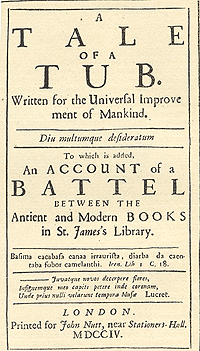
"The Battle of the Books" is a short satire written by Jonathan Swift and published as part of the prolegomena to his A Tale of a Tub in 1704. It depicts a literal battle between books in the King's Library, as ideas and authors struggle for supremacy. Because of the satire, "The Battle of the Books" has become a term for the Quarrel of the Ancients and the Moderns. It is one of Swift's earliest well-known works.

Standing on the Shoulder of Giants is the fourth studio album by English rock band Oasis, released on 28 February 2000. It was the band's first album under their new record label Big Brother Recordings. In the year preceding the album's release, Alan McGee closed Creation Records, and Oasis had lost two founding members and hired new producer Mark "Spike" Stent to replace Owen Morris.
"God is dead" is a statement made by the German philosopher Friedrich Nietzsche. The first instance of this statement in Nietzsche's writings is in his 1882 The Gay Science, where it appears three times. The phrase also appears at the beginning of Nietzsche's Thus Spoke Zarathustra.
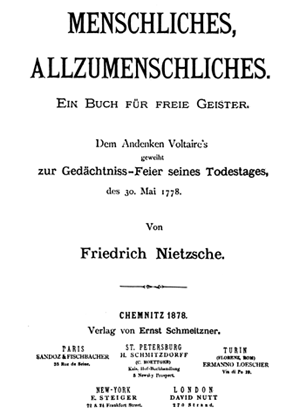
Human, All Too Human: A Book for Free Spirits is a book by 19th-century philosopher Friedrich Nietzsche, originally published in 1878. A second part, Assorted Opinions and Maxims, was published in 1879, and a third part, The Wanderer and his Shadow, followed in 1880.
The will to power is a concept in the philosophy of Friedrich Nietzsche. The will to power describes what Nietzsche may have believed to be the main driving force in humans. However, the concept was never systematically defined in Nietzsche's work, leaving its interpretation open to debate. Usage of the term by Nietzsche can be summarized as self-determination, the concept of actualizing one's will onto one's self or one's surroundings, and coincides heavily with egoism.

The Will to Power is a book of notes drawn from the literary remains of the philosopher Friedrich Nietzsche by his sister Elisabeth Förster-Nietzsche and Peter Gast. The title derived from a work that Nietzsche himself had considered writing. The work was first translated into English by Anthony M. Ludovici in 1910, and it has since seen several other translations and publications.

The Quarrel of the Ancients and the Moderns was a debate about literary and artistic merit, which expanded from the original debaters to the members of the Académie Française and the French literary community in the 17th century.

In the history of calculus, the calculus controversy was an argument between the mathematicians Isaac Newton and Gottfried Wilhelm Leibniz over who had first invented calculus. The question was a major intellectual controversy, which began simmering in 1699 and broke out in full force in 1711. Leibniz had published his work first, but Newton's supporters accused Leibniz of plagiarizing Newton's unpublished ideas. Leibniz died in 1716, shortly after the Royal Society, of which Newton was a member, found in Newton's favor. The modern consensus is that the two men developed their ideas independently.

Friedrich Nietzsche (1844–1900) developed his philosophy during the late 19th century. He owed the awakening of his philosophical interest to reading Arthur Schopenhauer's Die Welt als Wille und Vorstellung and said that Schopenhauer was one of the few thinkers that he respected, dedicating to him his essay Schopenhauer als Erzieher, published in 1874 as one of his Untimely Meditations.
Amor fati is a Latin phrase that may be translated as "love of fate" or "love of one's fate". It is used to describe an attitude in which one sees everything that happens in one's life, including suffering and loss, as good or, at the very least, necessary.

The Hedgehog, the Fox, and the Magister's Pox (2003) is Stephen Jay Gould's posthumous volume exploring the historically complex relationship between the sciences and the humanities in a scholarly discourse.
Sweetness and light is an English idiom that can be used in common speech, either as statement of personal happy consciousness, or as literal report on another person. Depending upon sense-of-humour, some may use the phrase with mild irony. For example: The two had been fighting for a month, but around others it was all sweetness and light. Esteemed humorous writer P. G. Wodehouse employed the phrase often, sometimes with a slight nod to the phrase's dual-edge. Originally, however, "sweetness and light" had a special use in literary and cultural criticism meaning "pleasing and instructive", which in classical theory was considered to be the aim and justification of poetry.
